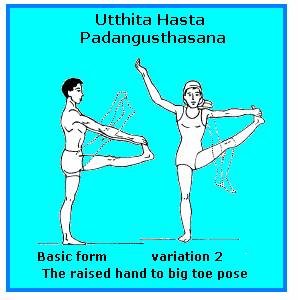UTTHITA HASTA PADANGUSTHASANA




Related Post 

Exercise-129: Utthita hasta padangusthasana (The raised hand to big toe pose)
- Stand erect with the feet together and the hands on the hips.
- Relax the whole body.
- Bend the right leg at the knee and raise the thigh as near as possible to the chest.
- Grasp the big toe of the raised foot with the right hand fingers.
- The right arm should be outside the bent leg.
- Straighten the right leg and slowly pull it upward.
- Maintain this pose for a comfortable length of time.
- Release the toe and slowly lower the leg to the ground, keeping it straight.
Variation-1:
- Repeat the basic form but hold the raised straight leg with both hands.
- Clasp the fingers together and place them behind the heel.
- Using the arms as levers, try to gently pull the leg as near as possible to the head.
- Advanced practitioners may be able to touch their chin to the raised leg.
Variation-2:
- Stand erect with the feet together.
- Bend the right leg at the knee and raise the thigh as high as possible towards the chest.
- Hold the big toe of the right foot with the right hand.
- The arm should be on the inside of the right leg.
- Slowly straighten the raised leg to the side.
- Raise the left arm pointing it to the left and upward.
- Then try to gently pull the straight raised leg higher and closer to the body.
- Maintain the final pose for a comfortable length of time.
- Then slowly lower the raised leg to the floor.
Breathing-
- For all three forms, exhale while straightening the raised leg, and then inhale.
- Exhale while pulling the leg higher and closer to the body.
- Breathe deeply in the final pose.
- Exhale while lowering the leg.
Duration-
The final pose of each form can be held for up to 60 seconds. Those people who are unable to maintain the pose can repeat 5 times, with each leg.
Concentration-
On a fixed point in front of the body.
Precautions-
Do not strain the leg muscles.
Benefits-
- All forms improve concentration and co-ordinate muscular and nervous balance.
- Strengthens and stretches the leg muscles.
GO BACK